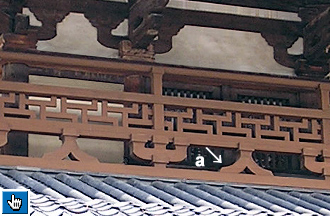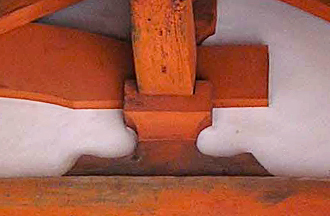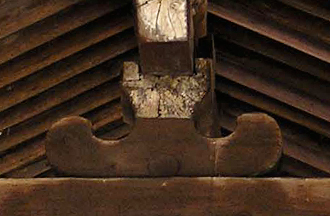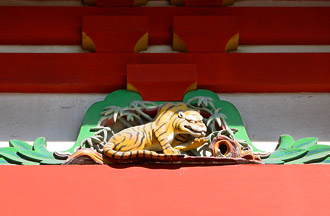Frog-leg
strut. A strut with legs spread like those of a frog. Kaerumata in the early Nara period developed from an inverted warizuka 割束 shaped strut to a very thick strut rounded on each end with an onion-shape
carved halfway through, horishizume 彫沈. Frog-leg struts are usually
positioned between parallel purlins *keta 桁 in the space between the bracket systems *tokyou 斗きょう that are atop each pillar. Frog-leg struts are also used to support
transverse rainbow beams *kouryou 虹梁 that stretch across the core *moya 母屋 of a temple building or across the smaller transverse beams of the aisles
*hisashi 廂. They are
also frequently found in gable ends. The oldest frog-leg struts were shaped
from single thick boards with no open spaces and were used to carry large
bearing blocks and bracket arms *daito
hijiki 大斗肘木 that in turn supported heavy beams *nuki 貫. This type of frog-leg strut is called itakaerumata 板蟇股. These solid
board frog-leg struts were completely functional. The struts placed between
two rainbow beams were wider than they were high. However, those positioned
on beams to support the ridge were higher than their width. The use of solid-board
frog-leg struts did not die out even though they were used less frequently
from the Heian period through to the 13c. From the 10 - 11c, kaerumata began to have some open areas, and the timber used became thinner. Those
with open spaces are called either honkaerumata 本蟇股 or *kurinuki
kaerumata 刳抜蟇股. One method to shape the frog-leg strut was to use
a single piece of wood and then cut openings to make a design. This is called
*sukashikaerumata 透蟇股. The shape of the openwork gradually changed. The legs became shorter,
stretched out further, and the feet were elongated. Carvings gradually
became more ornate in the latter Heian period and continued through the
latter Kamakura period when intricate arabesques and even *houju 宝珠 (treasure jewels) were included within the frame of the frog-legs. The
inside decoration of frog-leg struts in the Nanbokuchou and
the Muromachi periods became much more decorative and filled
the entire space. Houju, lotus, arabesques, flame patterns peonies,
paulownia, birds and clouds embellished the once simple frog-leg frame.
During the Momoyama and Edo periods the carvings
within the frog's legs are often elaborate and many are brilliantly colored.
Proportions of legs and feet changed and the bearing block on top of the
frog-leg strut is often undersize. Some excellent work of sculpture filling
the area between the frog-legs continued through most of the 17c. The left
and right pieces were carved out in reverse directions so that when combined
a triangular shaped frog-leg strut was produced. This method was called
the *gasshou 合掌 style.
The upper part was curved to create a place for the insertion of the base
of a bearing block *masu 斗. It is presumed from the paucity of examples that this technique never
became popular. For a relatively short time a different process was devised
to create decorative frog-leg struts: The strut was shaped and then cut
in half vertically.
|






